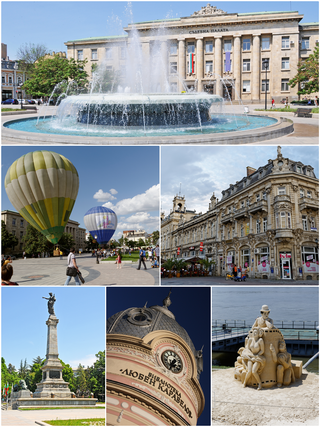
Ruse is the fifth largest city in Bulgaria. Ruse is in the northeastern part of the country, on the right bank of the Danube, opposite the Romanian city of Giurgiu, approximately 67 km (42 mi) south of Bucharest, Romania's capital, 172 km (107 mi) from Varna, and 249 km (155 mi) from the capital Sofia. Thanks to its location and its railway and road bridge over the Danube, it is the most significant Bulgarian river port, serving an important part of the international trade of the country. It is the 12th largest of all cities on the Danube river.

Vidin is a port city on the southern bank of the Danube in north-western Bulgaria. It is close to the borders with Romania and Serbia, and is also the administrative centre of Vidin Province, as well as of the Metropolitan of Vidin.
Ivan Sratsimir, or Ivan Stratsimir, was emperor (tsar) of Bulgaria in Vidin from 1356 to 1396. He was born in 1324 or 1325, and he died in or after 1397. Despite being the eldest surviving son of Ivan Alexander, Ivan Sratsimir was disinherited in favour of his half-brother Ivan Shishman and proclaimed himself emperor in Vidin. When the Hungarians attacked and occupied his domains, he received assistance from his father and the invaders were driven away.

Ivan Shishman ruled as emperor (tsar) of Bulgaria in Tarnovo from 1371 to 3 June 1395. The authority of Ivan Shishman was limited to the central parts of the Bulgarian Empire.
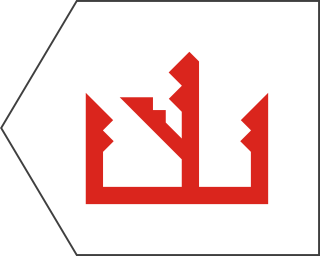
The Second Bulgarian Empire was a medieval Bulgarian state that existed between 1185 and 1396. A successor to the First Bulgarian Empire, it reached the peak of its power under Tsars Kaloyan and Ivan Asen II before gradually being conquered by the Ottomans in the early 15th century.
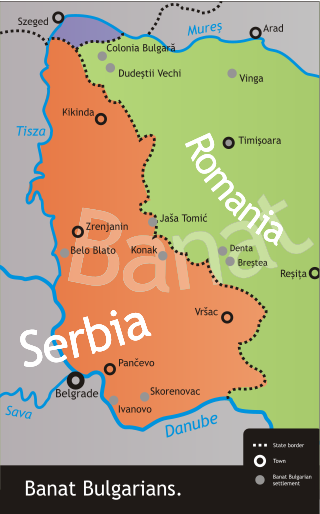
The Banat Bulgarians, also known as Bulgarian Roman Catholics and Bulgarians Paulicians or simply as Paulicians, are a distinct Bulgarian minority group which since the Chiprovtsi Uprising in the late 17th century began to settle in the region of the Banat, which was then ruled by the Habsburgs and after World War I was divided between Romania, Serbia, and Hungary. Unlike most other Bulgarians, they are Roman Catholic by confession and stem from groups of Paulicians and Roman Catholics from modern northern and northwestern Bulgaria.

The Despotate of Dobruja or Principality of Karvuna was a 14th-century quasi-independent Bulgarian polity in the region of modern Dobruja, that split off from the Second Bulgarian Empire under the influence of the Byzantine Empire. The Despotate of Dobruja existed from 1356 to 1411.

Bardarski Geran is a village in northwestern Bulgaria, part of Byala Slatina Municipality, Vratsa Province. It is among the several villages founded by Banat Bulgarians returning from the Banat after the Liberation of Bulgaria from Ottoman rule in 1878, and is thus predominantly Roman Catholic. It is regarded as "the capital of Banat Bulgarians in Bulgaria" by certain members of the community.

Germans are a minority ethnic group in Bulgaria. Although according to the 2001 census they numbered 436, the settlement of Germans in Bulgaria has a long and eventful history and comprises several waves, the earliest in the Middle Ages.
Dorothea of Bulgaria, also called Doroslava, was the first Queen of Bosnia. Daughter of the Bulgarian tsar Ivan Sratsimir, Dorothea was held hostage by King Louis I of Hungary, who married her off to Ban Tvrtko I of Bosnia in 1374. She became queen in 1377 and may have been the mother of King Tvrtko II.

The Bulgarian–Ottoman wars were fought between the kingdoms remaining from the disintegrating Second Bulgarian Empire, and the Ottoman Empire, in the second half of the 14th century. The wars resulted with the collapse and subordination of the Bulgarian Empire, and effectively came to an end with the Ottoman conquest of Tarnovo in July 1393, although other Bulgarian states held out slightly longer, such as the Tsardom of Vidin until 1396 and the Despotate of Dobruja until 1411. As a result of the wars the Ottoman Empire greatly expanded its territory on the Balkan peninsula, stretching from the Danube to the Aegean Sea.
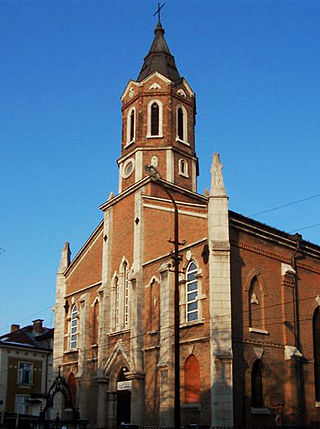
The Diocese of Nicopolis is a Latin diocese of the Catholic Church, which includes the whole northern part of Bulgaria. The seat of the episcopal see is in Rousse, although the diocese is named after Nicopolis ad Istrum. The diocese is immediately subject of the Holy See.
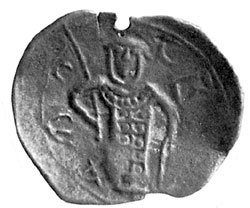
Jacob Svetoslav was a prominent 13th-century Bulgarian noble (bolyarin) of Rus' origin. Bestowed the title of despot, Jacob Svetoslav was the ruler of a widely autonomous domain of the Second Bulgarian Empire most likely located around Sofia. Seeking further independence and claiming the title of Emperor of Bulgaria, he twice changed allegiance from Bulgaria to the Kingdom of Hungary and vice versa, and the Hungarians recognized his Bulgarian royal rank as their vassal and ruler of Vidin.
Ivan the Russian was a 14th-century Bulgarian military leader of Russian origin who served Bulgarian tsars Michael Shishman and Ivan Alexander. Prior to joining the armed forces of the Second Bulgarian Empire, Ivan the Russian may have been a military commander in the service of the Hungarian governor of Severin.
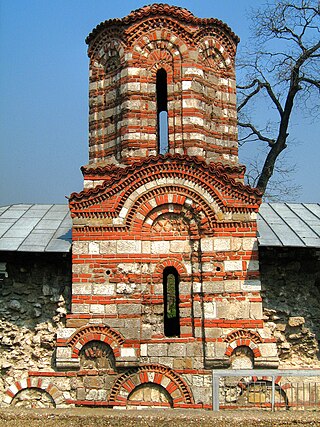
The Church of Saints Peter and Paul is a partially preserved medieval Eastern Orthodox church in the town of Nikopol, which lies in north central Bulgaria on the south bank of the Danube and is administratively part of Pleven Province. The church was built in the 13th or 14th century and was decorated with brick and marble patterns. The west part of the church is entirely in ruins.
Samuel Dzhundrin was a Bulgarian Roman Catholic priest, an Augustinian friar and bishop of Nikopol, Bulgaria.
Romylos of Vidin, also known as Romylos of Ravanica or Romylus the Athonite, was a 14th-century Bulgarian monk, a disciple of Gregory of Sinai. He is also known as the teacher of Grigorije of Gornjak. He is regarded as part of both Bulgarian and Serbian literature.

Strahil Kavalenov is a Bulgarian Catholic clergyman and the current bishop of the Nicopolis.











